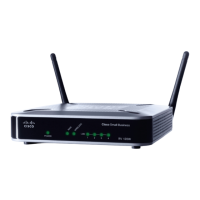Configuring Networking
Configuring Routing
Cisco RV 120W Administration Guide 50
2
STEP 3 Enter the route name.
STEP 4 If a route is to be immediately active, check the Active box. When a route is added
in an inactive state, it will be listed in the routing table, but will not be used by the
router. The route can be enabled later. This feature is useful if the network that the
route connects to is not available when you added the route. When the network
becomes available, the route can be enabled.
STEP 5 Check the Private box to mark this route as private, which means that it will not be
shared in a Routing Information Protocol (RIP) broadcast or multicast. Uncheck this
box if the route can be shared with other routers when RIP is enabled.
STEP 6 In the destination IP address field, enter the IP address of the destination host or
network to which the route leads. For a standard Class C IP domain, the network
address is the first three fields of the Destination LAN IP; the last field should be
zero.
STEP 7 In the IP subnet mask field, enter the IPv4 Subnet Mask for the destination host or
network. For Class C IP domains, the Subnet Mask is 255.255.255.0.
STEP 8 Choose the physical network interface through which this route is accessible
(WAN or LAN).
STEP 9 In the gateway IP address field, enter the IP Address of the gateway through which
the destination host or network can be reached. If this router is used to connect
your network to the Internet, then your gateway IP is the router's IP address. If you
have another router handling your network's Internet connection, enter the IP
address of that router instead.
STEP 10 In the metric field, enter a value between 2 and 15 to define the priority of the
route. If multiple routes to the same destination exist, the route with the lowest
metric is chosen.
STEP 11 Click Save.
Configuring Dynamic Routing
RIP (Routing Information Protocol, RFC 2453) is an Interior Gateway Protocol (IGP)
that is commonly used in internal networks. It allows the router to exchange its
routing information automatically with other routers, and allows it to dynamically
adjust its routing tables and adapt to changes in the network.

